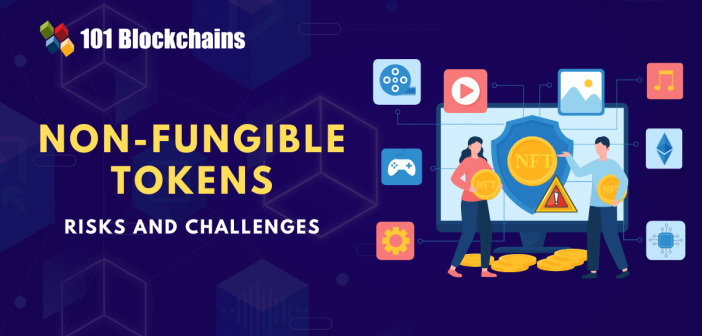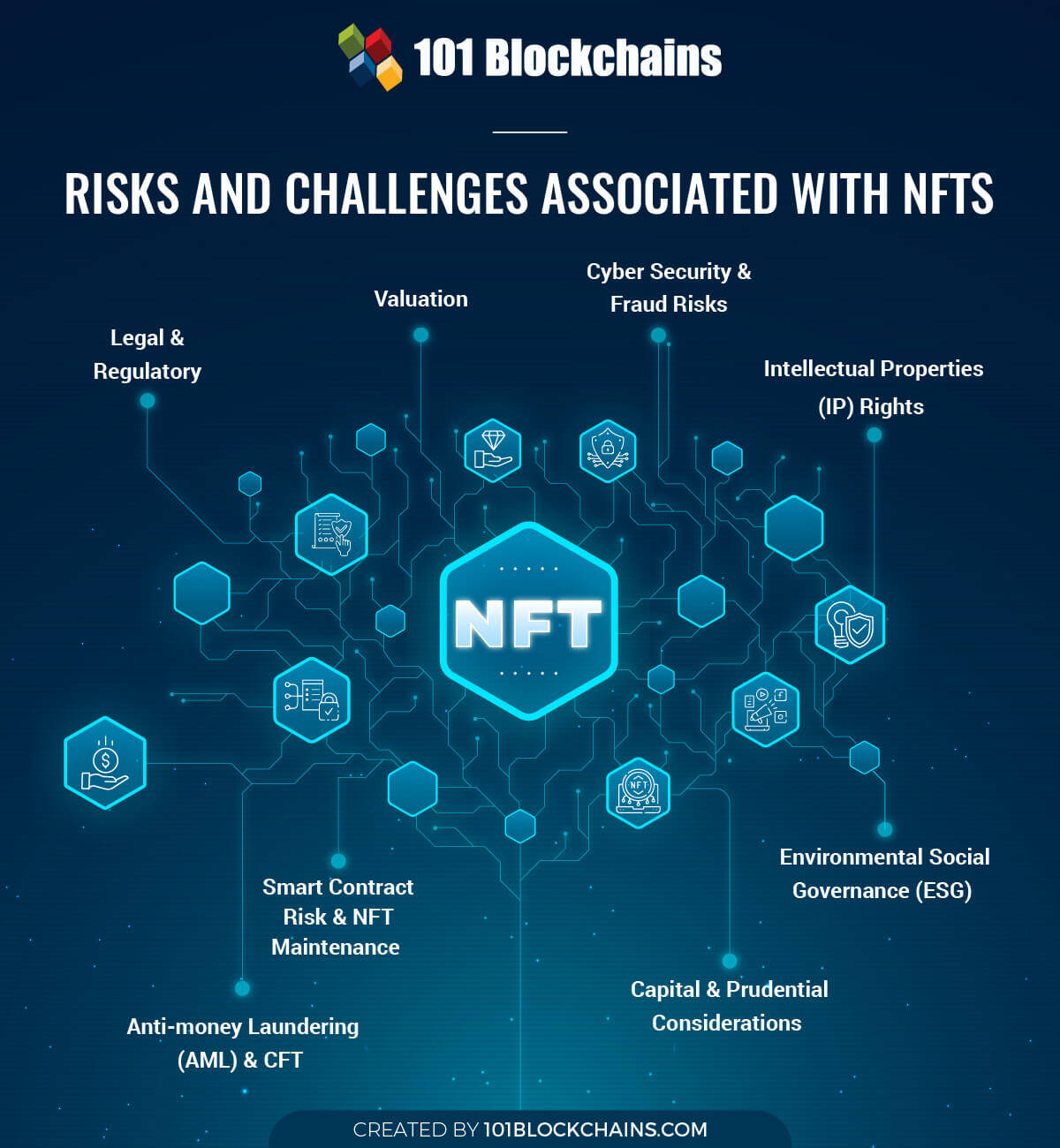Learn how blockchain truly works, master key definitions, and uncover what makes smart contracts so "smart." Dive into the fundamentals, gain valuable insights, and start your blockchain journey today!

- Guides
101 Blockchains
- on September 14, 2021
Non-Fungible Tokens – Risks and Challenges
NFTs have created quite a huge splash in 2021, especially after the $69.3 million NFT sales in March. Many people are debating over how long the NFT trend would last. So, it is important to reflect on prominent NFT risks and challenges. NFTs or non-fungible tokens are unique digital assets. They have distinct properties, and it is difficult to exchange them with other assets.
Non-fungible tokens have made their way into different types of applications such as music, domain names, artwork, and real estate. While NFTs show promising opportunities for growth in the future, it is reasonable to reflect on the potential NFT risks. The following discussion helps you find a detailed overview of risks and challenges associated with NFT to help you understand them better.
Aspiring to Become a Certified NFT Expert? Enroll in Certified NFT Professional (CNFTP) Course Now!
Challenges and Risks with NFTs
Non-fungible tokens or NFTs are a completely new type of digital asset, thereby implying the possibilities for radical fluctuations and uncertainty in the NFT ecosystem. The common types of NFT challenges include the following,
- Legal and regulatory challenges
- Evaluation challenges
- Intellectual Property or IP rights
- Cybersecurity and fraud risks
- Anti-money laundering (AML) and CFT challenges
- Smart contract risks and NFT maintenance
- Consideration of NFTs as securities
- Environmental Social Governance (ESG) challenges
Want to get an in-depth understanding of non-fungible tokens (NFTs)? Join Standard/Premium Plan and get free access to NFT Fundamentals Course.
Let us take a detailed overview of these risks and challenges of NFT to understand how they can impact NFTs.
1. Legal and Regulatory Challenges
NFT does not have a specific definition and can describe a wide variety of assets, and relies only on specific traits. For example, NFTs are unique, they are not interchangeable, and they are not fungible. However, there are some examples of regulatory approaches directed towards NFTs. In the case of Europe, the European Commission’s proposed Markets in Crypto-assets (MICA) Regulation could provide a regulatory framework for NFTs.
Existing legislative proposals imply possible differences in management of NFTs in the future under EU and UK regulatory environments. The Markets in Crypto Assets Regulation proposal issued in September 2020 in the European Union can serve as a foundation for regulating specific NFT-related market activities. On the other hand, the existing regulatory precedents in the UK are most likely to exclude NFTs. However, a case-by-case evaluation of the ways of selling or marketing NFTs and deriving value from them could help in determining whether NFTs would come under regulatory precedents. Interestingly, the definition of ‘crypto-assets’ by MICA includes NFTs. Furthermore, the existing draft of the definition of ‘crypto-assets’ by MICA does not imply the requirement of publishing a whitepaper for NFT issuers.
In the UK, the concept of qualifying crypto assets indicates that NFTs could be exempted from the UK promotion regime according to the FCA guidelines. Depending on the characteristics of the NFTs, NFTs may qualify as e-money tokens, security tokens, or unregulated tokens in these regulatory circumstances.
NFTs do not qualify as legal tender in Singapore. Additionally, they could also come in the category of “limited purpose digital payment tokens”, thereby excluding them from regulations in accordance to the PSA. The exclusion of NFTs is basically because they are non-fungible and are exchangeable only with particular goods.
In the case of Japan, the classification of NFTs depends on the capability of the NFTs to serve an economic function, such as the function of a means of payment or could be exchanged for cryptocurrencies, in which case they would be caught under the Payment Services Act of Japan. NFTs with limited functions, such as in-game items or trading cards, and no involvement in economic functions such as payment instruments, do not come under the jurisdiction of the Payment Services Act. Such types of NFTs should go through detailed examination and evaluation, in accordance with functions and specifications of the concerned NFT. In addition, the structure of the platform or application used for the NFT alongside the way of using the NFT should also be taken into account.
The importance of reflecting on the legal and regulatory NFT risks is clearly evident from the technological advancement in NFTs. As NFTs continue to grow and expand into different use cases, the laws and regulations should be capable of adapting. As of now, many of the existing laws pertaining to NFT are stuck on finding the ideal definition for NFTs. With the increasing variety and number of NFTs, it is difficult to find a solid ground for compliance in NFTs.
Learn the concept, elements, future and use cases of NFTs from the E-book: Non Fungible Tokens (NFTS) – A Definitive Guide
2. Evaluation Challenges
Another top addition among non-fungible tokens risks and challenges refers to the uncertainty in determining the value of NFTs. The valuation of NFTs depends considerably on scarcity and the perception of owners and buyers alongside the availability of distribution channels. It is extremely difficult to anticipate the identity of the next buyer of an NFT or the possible factors which can drive their purchase. Therefore, the value of NFTs would basically depend on how the buyer perceives their price, thereby leading to fluctuations.
3. Intellectual Property Rights
The next critical entry among risk and challenges of NFT refers to intellectual property issues. It is important to consider the ownership rights of an individual to a particular NFT. When you are trying to purchase an NFT, it is important to find out whether the seller actually owns the NFT. There have been examples of people clicking photos of NFTs or minting NFT replicas. So, when you buy an NFT, you only get the right to use the NFT rather than intellectual property rights. The terms and conditions for ownership of an NFT are evident in the metadata of the underlying smart contract.
The NFT risks and challenges related to intellectual property rights suggest that buyers only have the right to display NFTs and that they are the sole owners. The limitations of NFTs are also evident in terms of the service that users should follow when using NFT marketplaces. However, it is important to ward off all misconceptions regarding traditional law not being applicable for decentralized blockchain technology. So, it is important to reflect on important IP rights considerations such as copyrights, trademarks, patents, moral rights, and the right to publicity.
Build your identity as a certified blockchain expert with 101 Blockchains’ Blockchain Certifications designed to provide enhanced career prospects.
4. Cyber Security and Fraud Risks
The growth of the digital world and staggering growth in popularity of NFTs has resulted in prominent cybersecurity and fraud risks. NFT risks of replica stores that appear similar to original NFT stores with the same logo and content from authentic stores. Another prominent challenge associated with the risks and challenges related to NFTs in cybersecurity refers to fake NFT stores. The fake NFT stores could sell off NFTs which are not present in the first place. At the same time, buyers must also be wary of the concerns due to artist impersonation or counterfeit NFTs.
Some malicious agents can impersonate famous NFT artists and sell fake NFTs in their names. The other prominent non-fungible tokens risks and challenges related to cybersecurity and fraud include copyright theft, replication of popular NFTs or fake airdrops, and NFT giveaways. You should also note the threats of risks due to social media scams that may promote NFTs.
For example, some entities minted NFTs from artworks in the digital collection of public domain works displayed at the Rijksmuseum in Amsterdam without the consent of the museum. One of the recent examples of the NFT cybersecurity threat refers to the incident of hackers stealing NFTs from Nifty Gateway users.
5. Smart Contract Risks and NFT Maintenance
The mention of smart contract risk and challenges of NFT maintenance is also one of the prominent concerns in the NFT landscape presently. Most recently, the renowned DeFi protocol Poly Network, featuring cross-chain interoperability, was under attack by hackers. With almost $600 million stolen in the NFT theft, the incident draws the limelight towards profound setbacks in smart contract security.
Hackers were able to exploit the smart contract vulnerability of Poly Network for carrying out such large-scale attacks. The poly network enables users to swap tokens throughout different blockchain networks alongside helping them work together. As of the time of writing, the hackers had returned almost $300 million back to the Poly Network.
Curious to understand the complete smart contract development lifecycle? Enroll in Smart Contracts Development Course Now!
6. Consideration of NFTs as Securities
The consideration of NFTs as securities is also one of the prominent entries among non-fungible tokens risks and challenges. The Chairman of SEC has stated that the majority of NFTs offered in the market are sold as securities. However, the Supreme Court has associated NFTs with the definition of an investment contract. Therefore, NFTs have to comply with the specific requirements of the Howey Test to showcase eligibility as securities. The important tenets of the Howey Test include the following,
- Checking whether the NFT in question is a security
- If the NFT is a security, then check whether it has been registered according to the Securities Act of 1993
- If the NFT is security, check whether participants have registration as securities broker-dealers
- Check whether the platforms for security-like NFT transactions have registration as securities exchanges
- Take the liability exposure for security NFT sellers in accordance with the SEC Rule 10b-5 for Employment of Manipulative and Deceptive Practices into account.
7. AML and CFT Challenges
The FATF issued a report in July citing that distributed ledger technology presents challenges. The report focused on NFT risks and challenges, referring particularly to an AML/CFT point of view. Decentralized transactions on the blockchain along with support for non-intermediary peer-to-peer transactions without any monitoring can lead to AML and CFT challenges. In addition, NFTs are also associated with jurisdictional challenges as there is no specific precedent for regulating NFTs.
As a result, it could also challenge the conventional FATF standards, which emphasized regulation or supervision of intermediaries. The Office of Foreign Asset Control (OFAC) issued an advisory warning in October 2020, citing high-value artwork as responsible for enabling access to the US market and financial system for blocked persons.
Start learning Non-Fungible Token with World’s first NFT Skill Path with quality resources tailored by industry experts Now!
Bottom Line
It is quite clear that the domain of NFTs suffers from a diverse range of risks and challenges. Since it is a newly developing domain, the resolution of non-fungible tokens risks and challenges will help its growth. The identification of multiple risks and challenges with real-life implications showcases the severity of each risk.
In addition, the overview of the impacts of each risk and challenge can help in discovering potential solutions to them. As the world opens up to NFTs, it is important to have a uniform regulatory infrastructure, unique and targeted AML and CFT guidelines, along with secure platforms for NFT creation and exchange. Learn more about NFTs and discover ways for resolving their challenges and risks.
*Disclaimer: The article should not be taken as, and is not intended to provide any investment advice. Claims made in this article do not constitute investment advice and should not be taken as such. Do your own research!






